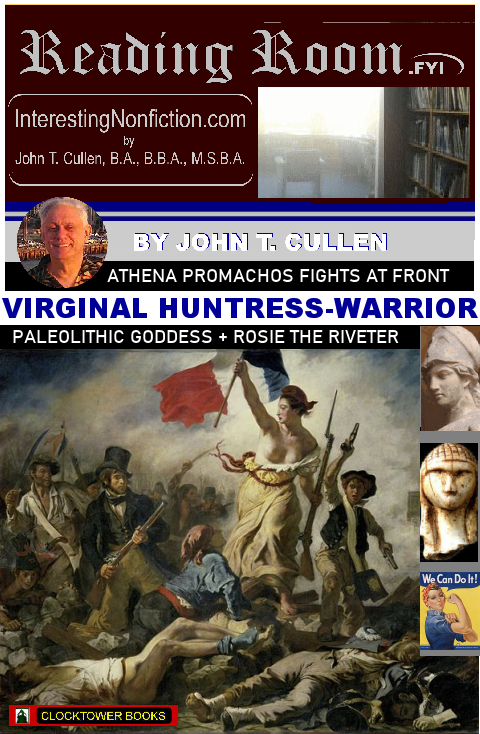|
Eternal, Sacred, Untouchable
Virginal Huntress: Ice Age Princess, Divine Virgin
From Artemis to Marianne to Rosie the Riveter and Beyond
Essay on History by John T. Cullen
Fierce, beautiful, and untouchable, the divine virgin still today brings with her a breath of Ice Age mystery. She is a source of endless fascination. Her shadow also surfaces in Christendom, but this article is not about Jesus or Mary; weíll reserve those topics for another day.
With minor variations, the virgin goddess who throws her powerful shadow across continents and centuries is Artemis, Athena, Joan of Arc, Marianne of the Barricades, and Rosie the Riveter. We tie together evidence from the Ice Ages through ancient Greece, Rome, and the Middle Ages, right up to modern times, showing that her cult has been around as long as mankind, and endures today.
She is the beautiful, strong, and tragic Penthesilea of Homerís Iliad, whom Achilles slew in battle and grieved deeply over her. She is the Volscian maiden Camilla, an Amazon who could run so fast over a field of wheat that her feet never brushed the stalks, and so fast over water that she never ruffled the waves. And yet she also dies tragically, mourned by the listeners of Virgilís Aeneid (which is strongly patterned on Homerís Iliad and Odyssey).
The Athena archetype (virgin hunter, female warrioró'promachos,' Fights In Front) is a glorious mystery in several ways. Why did the Athenians name their capital after her, and dedicate the sanctuary atop the High City or Acropolis in the name Parthenon, Temple of the Virgin?
Ionians worshipped her from at least Neolithic times. When Iron Age Hellenes in Attica settled the much more ancient city that would become Classical Athens, they named their city after the virgin: Athene, or Athens. Atop the city's highest hill, they created a sanctuary dedicated to her, and named its chief temple the Parthenon, which means Temple of the Virgin.
Why are figures like Artemis (ferocious, untouchable, feral girl-goddess who hunts with animals) and Athena, or a more modern virgin warrior like Joan of Arc, deeply embedded in the myth-making of humans? The authorís conjecture is that Artemis, and deities like her, are Paleolithic survivals with a specific cultural purpose.
The virgin develops a muted Neolithic identity in, for example, Kore (lit. Maiden), the virginal daughter of Demeter the earth and grain goddess. While picking flowers in a meadow with Artemis, another virginal deity, Kore is kidnapped by Hades and taken to the Underworld, where she is deflowered and made his wife. Ultimately, she is allowed to live above ground during spring and summer, but must return to be Hades' wife in the Underworld. Her infernal (underground) persona is the Greek Persephone or Periphone, and the Roman Proserpina. The name may possibly come from the fact that her distraught mother, Demeter, went everywhere searching and calling her name (periphonein). Itís a Neolithic tale, reflecting the miracle or mystery of the grain, which dies, goes underground, and is ultimately reborn when it sprouts. Before humans settled down, became farmers, and pastured livestock, humans were Paleolithic (Old Stone Age) or Mesolithic (Middle Stone Age) hunter-gatherers. They did not yet understand the miracle of planting, but gathered wild grains, fruits, and vegetables. They did not yet control or fence in herds of cattle and sheep, but migrated symbiotically with the animals.
This article suggests that the virginal huntress is an archetype dating to Paleolithic times. She is far older than the deities of Classical mythology. In a way, she is the best memory we have of the Ice Ages, when our race reached the modern intellectual and cultural capacity that still characterizes us today (albeit with farming, pasturing, cities, kings, priests, scriptures, dogmas, wars, and much else).
TOP
|
|
|
No print edition currently available. Kindle e-book only.
|
Browse or Buy at Amazon
The book linked at left is an e-book edition to browse; or buy & download from Amazon for your Kindle reader.
The middle link is for the corresponding print edition. Most of these are standard 6x9"; a few have added trim sizes available (5x8"). More info at Amazon.com.
Most print editions are also available at Barnes & Noble online; or call/visit your local bookstore to order.
|

|